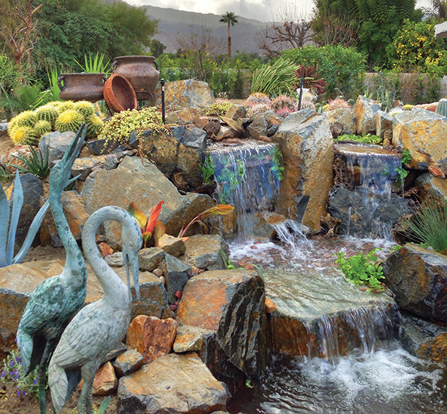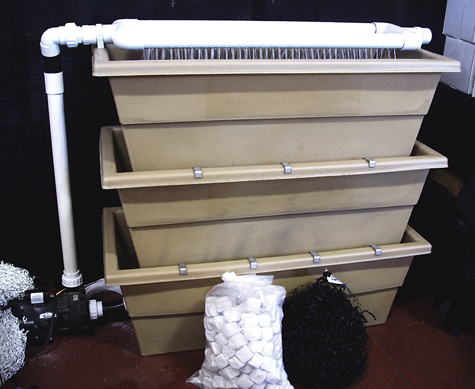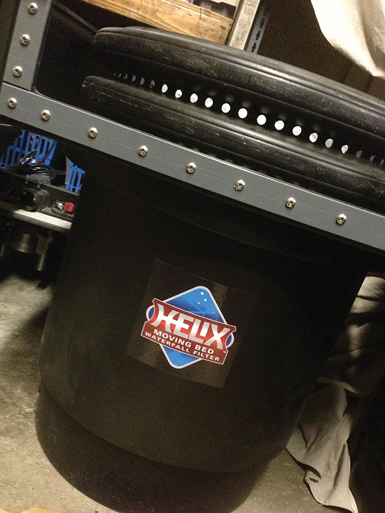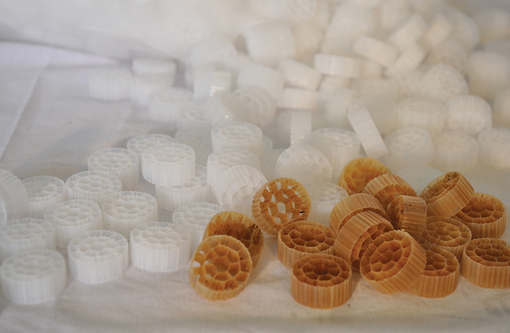
There are two primary categories of filtration in living water systems: pre-filtration and biofiltration. Pre-filtration consists of any filter that has the job of removing larger, suspended or sinking solids from the water column and the floating solids from the surface before the pump or other forms of filtration. This is an important function, which we will discuss in detail in a later issue.
Biofiltration is the name of the process in which the nitrogen cycle is accomplished. During this cycle the ammonia the fish produce is converted to nitrites and then into nitrates. A biofilter is essentially a protected space for the two types of bacteria that accomplish this cycle to thrive. The nitrosomonas and nitrobacter bacteria are found nearly everywhere in nature and do their job as the environment requires. In an artificial pond system the bacterial colonies live on every available underwater surface. The ratio of fish to water volume is much more concentrated in an artificial system than in nature, so a space with larger surface area for the bacteria to live on must be created. This additional real estate is called the biofilter.
Biofilters: Static vs. Aerated
Biofiltration can come in many types and styles, but for the most part it has two main categories: static (“plug-flow”) and aerated. Static biofiltration has no moving parts, as the name suggests. Static biofiltration both converts the ammonia and, because of its static nature, traps fine particles for water clarity. Aerated biofiltration has oxygen injected or exposed to it in a turbulent manner, which increases its performance. Both static and aerated biofiltration can use a variety of media to increase the surface area and, depending on media type, will vary in performance. This turbulent oxygenation prevents the filter from trapping fine particles.
Series | Best Pond Practices: This is an installment of an ongoing, multi-part series. Read last month’s installment, An Unnecessary Battle: Concrete and liners are teammates, not enemies.
The nitrogen cycle is an almost instantaneous reaction as water passes over the bacterial colonies through the biofilter. As compared to the speed of water near the other surfaces in the pond, the bioconversion happens at an increased rate with the larger concentrated surface area and faster speed of the water passing through the filter. All biofilters must be sized according to the maximum ammonia load possible. The colonies of bacteria will expand and contract according to fish load and temperature. Fish are cold-blooded and their metabolism changes with temperature, producing less ammonia in colder water than they will in warmer water. A well-designed biofilter will accommodate this expansion and contraction over time, maturing into an efficient bioconversion machine.
Static biofilters do a tremendous job of conversion depending on media type, but unlike aerated biofilters, they have a speed limit. The ammonia conversion is instantaneous, but the ability to trap fine particles and clarify the water is a function of speed vs. media type. In general a maximum flow rate of approximately 630 gallons per hour for each square foot of cross-sectional surface area is recommended. Flow rates above this speed tend to trap less debris, causing water clarity issues.
As an example, a 2-foot by 2-foot biofilter (2 x 2 x 630gph) should flow approximately 2,500gph for maximum water clarity. This is not a hard and fast rule, but an optimum one. A tighter media will allow a higher flow rate while a more open media requires a slower flow rate. Tighter media types require more energy to push through them while more open media types require less energy. Media types vary, from Matala pads to Japanese matting; brushes; lava rock; sand; gravel; plastic beads; and open media like Bacti-twist, Helix or Kaldness.
Static Biofilters Ranked
While all static biofilters work, my personal favorite for both water clarity and maximum surface area is an open-upflow sand and gravel filter. These are old-school but still the best and consist of layers of rock, gravel and course sand assembled in a vertical, open tank with an air blower to clean it. This filter is the best at “water polishing” because of the tight, compact nature of the top layer of course sand requiring about a quarter pound of pressure to operate.

Bacti-twist is my next favorite because of its “shaved” nature with lots of trapping surface area on a microscopic level as opposed to molded or extruded plastics. All static biofilters should have a method of cleaning, starting with a drain to empty the filter without allowing any of the collected detritus to return to the pond. Additionally, a method of agitation by mechanical means can be provided depending on media type. The use of air rings connected to an air pump or blower to agitate the media and dislodge the debris is an efficient method.
Pressurized bead filters are a popular method of static biofiltration because of their ease of installation, but I rarely use them. They require a high-pressure, high-energy pump, which places them lower on my list. Low-pressure pressurized filters are on the horizon, but generally I like to build gravity flow systems with open upflow or downflow tanks built into the ground or directly into waterfalls. Open upflow systems can also be built above ground with gravity flow back to the pond, requiring much less pressure and electricity to operate.
Aerated Biofilters
Aerated biofilters are of several types: static media with fine air bubbles flowing up through it, shower filters and moving beds. A static media filter with aeration is the simplest type and almost any static filter can be converted to an aerated biofilter by simply adding a fine bubble diffuser or aeration rings made from aeration tubing run by an appropriately sized air pump. The increased dissolved oxygen content in the water column created by aeration allows the bacterial colonies in the biofilter to shift into high gear. The amount of oxygen the bacteria consume or convert is widely underestimated. Just as the fish need oxygen, so do the bacteria.

This is one problem that can be associated with pressurized bead filters in some systems. Pressurized filters can starve for oxygen if sources of oxygen are not provided in some other manner. A waterfall does not always provide enough, so in-pond aeration is always a good addition. Formal ponds with no waterfall definitely need aeration or aerated biofiltration incorporated into the design.
Shower filters and trickle towers are basically like having a giant waterfall in a very compact space. Trickle towers are just a smaller version of shower filters with a much slower flow rate. Water is pumped up to a drip plate or spray bar assembly and the media below is “showered” with ammonia-rich water. The media is housed in stacked trays or baskets with the water splashing through onto the next tray and then into a collection chamber at the base, from which it returns to the pond.
Shower filters are extremely efficient, as the bacterial colonies are constantly wet but highly exposed to oxygen. They can be loud, just as a waterfall can be, but the sound can be controlled. The biggest issue with shower filters is hiding them! To date my favorite media for shower filters is a combination of Bacti-twist and MP2C. MP2C is a ceramic media produced by Cermedia with the highest surface area of any media on the market, but it must be used properly. With 98,000 square feet per cubic foot, the highly porous media is also the cheapest per square foot of any media on the market. With its highly porous nature it must be pre-filtered well, but when used properly it outperforms all others when it comes to ammonia conversion.
Moving Beds

Moving beds have media that moves or is tumbled by air. The purpose of a moving bed is to allow the ammonia-rich water to pass by the bacterial colonies on the surfaces of the media multiple times for each one-time pass through the filter. The media tumbles up and down through the filter at a faster rate than the water flowing through the filter to the outlet. The water has multiple opportunities to mix and come in contact with the bacteria and becomes highly oxygenated. Moving beds are like having multiple aerated static filters in parallel, all contained in the space of one filter container. Moving beds can be constructed in upflow or downflow configurations and are usually installed remotely.
Most waterfall filters on the market are static biofilters, but a couple of years ago I had the opportunity to design the first moving-bed waterfall filter. This was a collaboration between myself and Eric Triplett, owner of The Pond Digger. Recently someone has attempted to copy it and is claiming they designed it, so this should set the record straight!
I have also created what I call an air-driven dilution reactor (ADDR). This filter acts as a moving bed by cycling the water past the media and bacteria multiple times for each one-time pass through, but has no moving media. This allows the use of several media types instead of the proprietary floating open media created by the wastewater treatment industry.
With all these biofilters to choose from, designing a properly functioning pond system should be a challenge—but not a problem!



I purchased a pressurized filter that will be used with a biofilter waterfall box and pump, it has a uv bulb feature that requires electricity. Can I use the pressurized filter without electricity if I do not use the uv feature.